ESP FIAT 500 2020 Owner handbook (in English)
[x] Cancel search | Manufacturer: FIAT, Model Year: 2020, Model line: 500, Model: FIAT 500 2020Pages: 228, PDF Size: 6.01 MB
Page 141 of 228
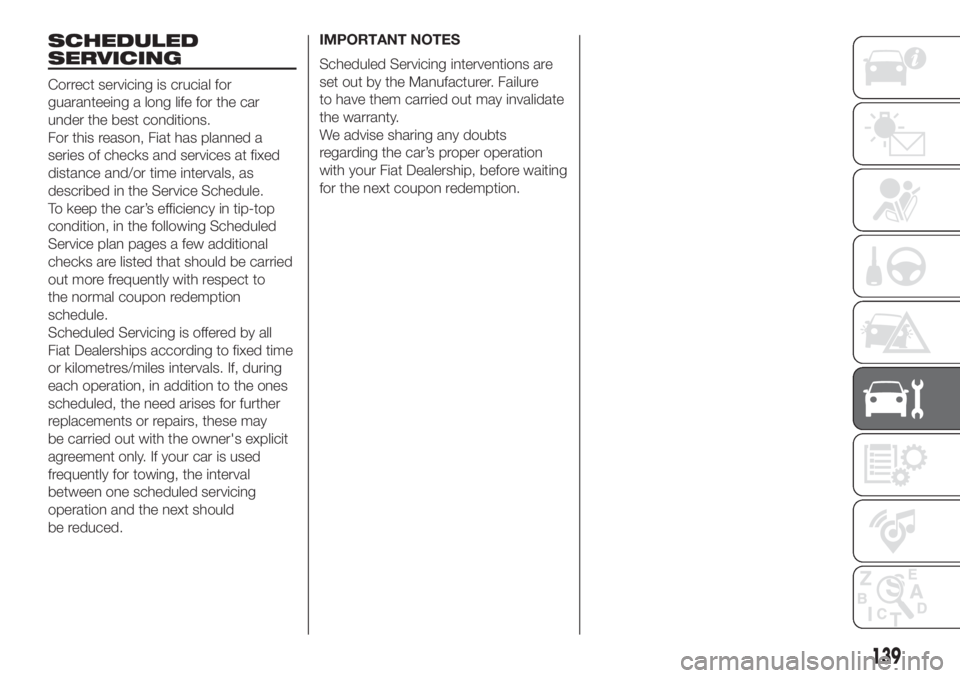
SCHEDULED
SERVICING
Correct servicing is crucial for
guaranteeing a long life for the car
under the best conditions.
For this reason, Fiat has planned a
series of checks and services at fixed
distance and/or time intervals, as
described in the Service Schedule.
To keep the car’s efficiency in tip-top
condition, in the following Scheduled
Service plan pages a few additional
checks are listed that should be carried
out more frequently with respect to
the normal coupon redemption
schedule.
Scheduled Servicing is offered by all
Fiat Dealerships according to fixed time
or kilometres/miles intervals. If, during
each operation, in addition to the ones
scheduled, the need arises for further
replacements or repairs, these may
be carried out with the owner's explicit
agreement only. If your car is used
frequently for towing, the interval
between one scheduled servicing
operation and the next should
be reduced.IMPORTANT NOTES
Scheduled Servicing interventions are
set out by the Manufacturer. Failure
to have them carried out may invalidate
the warranty.
We advise sharing any doubts
regarding the car’s proper operation
with your Fiat Dealership, before waiting
for the next coupon redemption.
139
Page 143 of 228
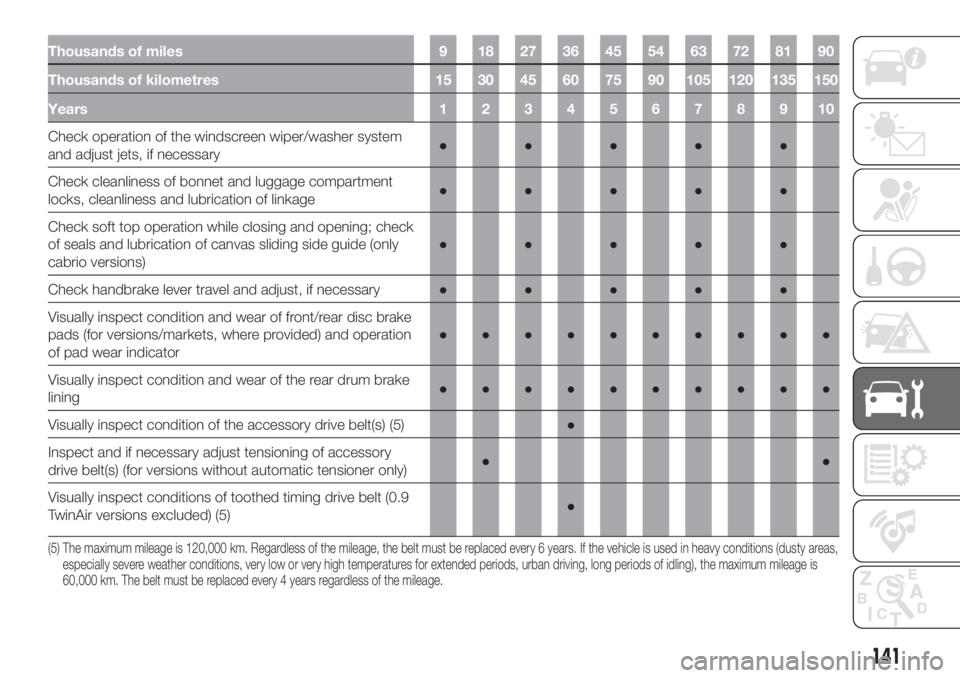
Thousands of miles 9 18 27 36 45 54 63 72 81 90
Thousands of kilometres 15 30 45 60 75 90 105 120 135 150
Years12345678910
Check operation of the windscreen wiper/washer system
and adjust jets, if necessary●●●●●
Check cleanliness of bonnet and luggage compartment
locks, cleanliness and lubrication of linkage●●●●●
Check soft top operation while closing and opening; check
of seals and lubrication of canvas sliding side guide (only
cabrio versions)●●●●●
Check handbrake lever travel and adjust, if necessary●●●●●
Visually inspect condition and wear of front/rear disc brake
pads (for versions/markets, where provided) and operation
of pad wear indicator●●●●●●●●●●
Visually inspect condition and wear of the rear drum brake
lining●●●●●●●●●●
Visually inspect condition of the accessory drive belt(s) (5)●
Inspect and if necessary adjust tensioning of accessory
drive belt(s) (for versions without automatic tensioner only)●●
Visually inspect conditions of toothed timing drive belt (0.9
TwinAir versions excluded) (5)●
(5) The maximum mileage is 120,000 km. Regardless of the mileage, the belt must be replaced every 6 years. If the vehicle is used in heavy conditions (dusty areas,
especially severe weather conditions, very low or very high temperatures for extended periods, urban driving, long periods of idling), the maximum mileage is
60,000 km. The belt must be replaced every 4 years regardless of the mileage.
141
Page 145 of 228
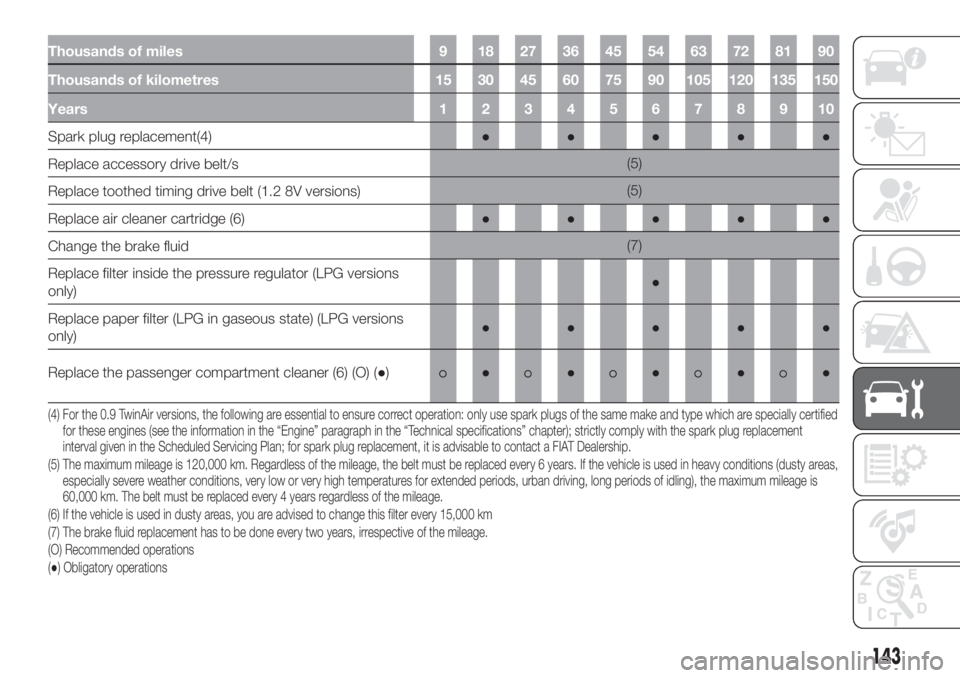
Thousands of miles 9 18 27 36 45 54 63 72 81 90
Thousands of kilometres 15 30 45 60 75 90 105 120 135 150
Years12345678910
Spark plug replacement(4)●●●●●
Replace accessory drive belt/s(5)
Replace toothed timing drive belt (1.2 8V versions)(5)
Replace air cleaner cartridge (6)●●●●●
Change the brake fluid(7)
Replace filter inside the pressure regulator (LPG versions
only)●
Replace paper filter (LPG in gaseous state) (LPG versions
only)●●●●●
Replace the passenger compartment cleaner (6) (O) (●)
●●●●●
(4) For the 0.9 TwinAir versions, the following are essential to ensure correct operation: only use spark plugs of the same make and type which are specially certified
for these engines (see the information in the “Engine” paragraph in the “Technical specifications” chapter); strictly comply with the spark plug replacement
interval given in the Scheduled Servicing Plan; for spark plug replacement, it is advisable to contact a FIAT Dealership.
(5) The maximum mileage is 120,000 km. Regardless of the mileage, the belt must be replaced every 6 years. If the vehicle is used in heavy conditions (dusty areas,
especially severe weather conditions, very low or very high temperatures for extended periods, urban driving, long periods of idling), the maximum mileage is
60,000 km. The belt must be replaced every 4 years regardless of the mileage.
(6) If the vehicle is used in dusty areas, you are advised to change this filter every 15,000 km
(7) The brake fluid replacement has to be done every two years, irrespective of the mileage.
(O) Recommended operations
(●) Obligatory operations
143
Page 149 of 228
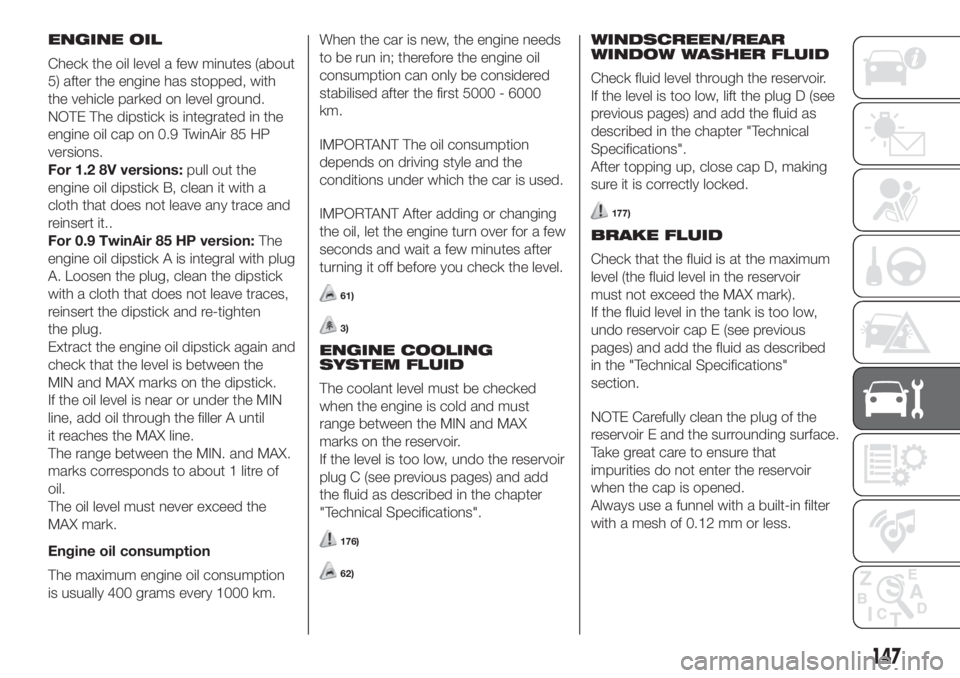
ENGINE OIL
Check the oil level a few minutes (about
5) after the engine has stopped, with
the vehicle parked on level ground.
NOTE The dipstick is integrated in the
engine oil cap on 0.9 TwinAir 85 HP
versions.
For 1.2 8V versions:pull out the
engine oil dipstick B, clean it with a
cloth that does not leave any trace and
reinsert it..
For 0.9 TwinAir 85 HP version:The
engine oil dipstick A is integral with plug
A. Loosen the plug, clean the dipstick
with a cloth that does not leave traces,
reinsert the dipstick and re-tighten
the plug.
Extract the engine oil dipstick again and
check that the level is between the
MIN and MAX marks on the dipstick.
If the oil level is near or under the MIN
line, add oil through the filler A until
it reaches the MAX line.
The range between the MIN. and MAX.
marks corresponds to about 1 litre of
oil.
The oil level must never exceed the
MAX mark.
Engine oil consumption
The maximum engine oil consumption
is usually 400 grams every 1000 km.When the car is new, the engine needs
to be run in; therefore the engine oil
consumption can only be considered
stabilised after the first 5000 - 6000
km.
IMPORTANT The oil consumption
depends on driving style and the
conditions under which the car is used.
IMPORTANT After adding or changing
the oil, let the engine turn over for a few
seconds and wait a few minutes after
turning it off before you check the level.
61)
3)
ENGINE COOLING
SYSTEM FLUID
The coolant level must be checked
when the engine is cold and must
range between the MIN and MAX
marks on the reservoir.
If the level is too low, undo the reservoir
plug C (see previous pages) and add
the fluid as described in the chapter
"Technical Specifications".
176)
62)
WINDSCREEN/REAR
WINDOW WASHER FLUID
Check fluid level through the reservoir.
If the level is too low, lift the plug D (see
previous pages) and add the fluid as
described in the chapter "Technical
Specifications".
After topping up, close cap D, making
sure it is correctly locked.
177)
BRAKE FLUID
Check that the fluid is at the maximum
level (the fluid level in the reservoir
must not exceed the MAX mark).
If the fluid level in the tank is too low,
undo reservoir cap E (see previous
pages) and add the fluid as described
in the "Technical Specifications"
section.
NOTE Carefully clean the plug of the
reservoir E and the surrounding surface.
Take great care to ensure that
impurities do not enter the reservoir
when the cap is opened.
Always use a funnel with a built-in filter
with a mesh of 0.12 mm or less.
147
Page 150 of 228
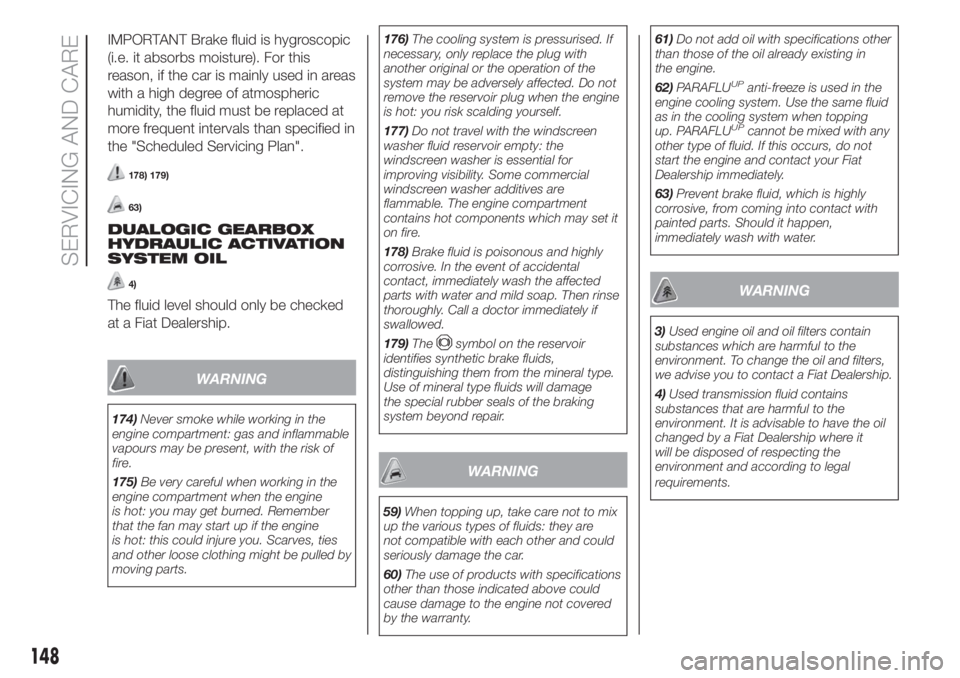
IMPORTANT Brake fluid is hygroscopic
(i.e. it absorbs moisture). For this
reason, if the car is mainly used in areas
with a high degree of atmospheric
humidity, the fluid must be replaced at
more frequent intervals than specified in
the "Scheduled Servicing Plan".
178) 179)
63)
DUALOGIC GEARBOX
HYDRAULIC ACTIVATION
SYSTEM OIL
4)
The fluid level should only be checked
at a Fiat Dealership.
WARNING
174)Never smoke while working in the
engine compartment: gas and inflammable
vapours may be present, with the risk of
fire.
175)Be very careful when working in the
engine compartment when the engine
is hot: you may get burned. Remember
that the fan may start up if the engine
is hot: this could injure you. Scarves, ties
and other loose clothing might be pulled by
moving parts.176)The cooling system is pressurised. If
necessary, only replace the plug with
another original or the operation of the
system may be adversely affected. Do not
remove the reservoir plug when the engine
is hot: you risk scalding yourself.
177)Do not travel with the windscreen
washer fluid reservoir empty: the
windscreen washer is essential for
improving visibility. Some commercial
windscreen washer additives are
flammable. The engine compartment
contains hot components which may set it
on fire.
178)Brake fluid is poisonous and highly
corrosive. In the event of accidental
contact, immediately wash the affected
parts with water and mild soap. Then rinse
thoroughly. Call a doctor immediately if
swallowed.
179)The
symbol on the reservoir
identifies synthetic brake fluids,
distinguishing them from the mineral type.
Use of mineral type fluids will damage
the special rubber seals of the braking
system beyond repair.
WARNING
59)When topping up, take care not to mix
up the various types of fluids: they are
not compatible with each other and could
seriously damage the car.
60)The use of products with specifications
other than those indicated above could
cause damage to the engine not covered
by the warranty.61)Do not add oil with specifications other
than those of the oil already existing in
the engine.
62)PARAFLU
UPanti-freeze is used in the
engine cooling system. Use the same fluid
as in the cooling system when topping
up. PARAFLU
UPcannot be mixed with any
other type of fluid. If this occurs, do not
start the engine and contact your Fiat
Dealership immediately.
63)Prevent brake fluid, which is highly
corrosive, from coming into contact with
painted parts. Should it happen,
immediately wash with water.
WARNING
3)Used engine oil and oil filters contain
substances which are harmful to the
environment. To change the oil and filters,
we advise you to contact a Fiat Dealership.
4)Used transmission fluid contains
substances that are harmful to the
environment. It is advisable to have the oil
changed by a Fiat Dealership where it
will be disposed of respecting the
environment and according to legal
requirements.
148
SERVICING AND CARE
Page 158 of 228
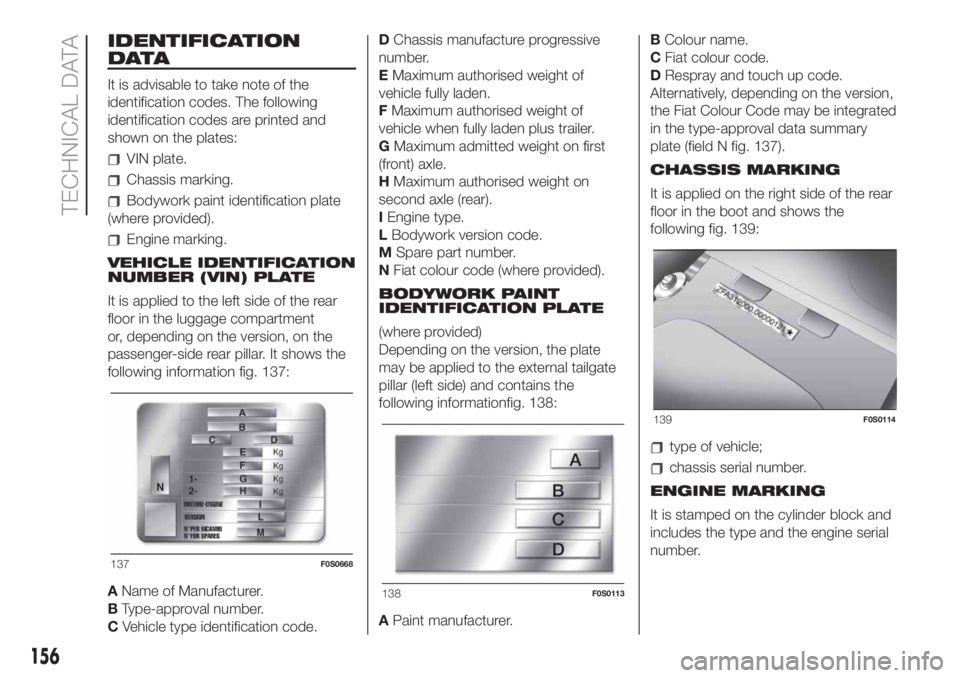
IDENTIFICATION
DATA
It is advisable to take note of the
identification codes. The following
identification codes are printed and
shown on the plates:
VIN plate.
Chassis marking.
Bodywork paint identification plate
(where provided).
Engine marking.
VEHICLE IDENTIFICATION
NUMBER (VIN) PLATE
It is applied to the left side of the rear
floor in the luggage compartment
or, depending on the version, on the
passenger-side rear pillar. It shows the
following information fig. 137:
AName of Manufacturer.
BType-approval number.
CVehicle type identification code.DChassis manufacture progressive
number.
EMaximum authorised weight of
vehicle fully laden.
FMaximum authorised weight of
vehicle when fully laden plus trailer.
GMaximum admitted weight on first
(front) axle.
HMaximum authorised weight on
second axle (rear).
IEngine type.
LBodywork version code.
MSpare part number.
NFiat colour code (where provided).
BODYWORK PAINT
IDENTIFICATION PLATE
(where provided)
Depending on the version, the plate
may be applied to the external tailgate
pillar (left side) and contains the
following informationfig. 138:
APaint manufacturer.BColour name.
CFiat colour code.
DRespray and touch up code.
Alternatively, depending on the version,
the Fiat Colour Code may be integrated
in the type-approval data summary
plate (field N fig. 137).
CHASSIS MARKING
It is applied on the right side of the rear
floor in the boot and shows the
following fig. 139:
type of vehicle;
chassis serial number.
ENGINE MARKING
It is stamped on the cylinder block and
includes the type and the engine serial
number.
137F0S0668
138F0S0113
139F0S0114
156
TECHNICAL DATA
Page 159 of 228
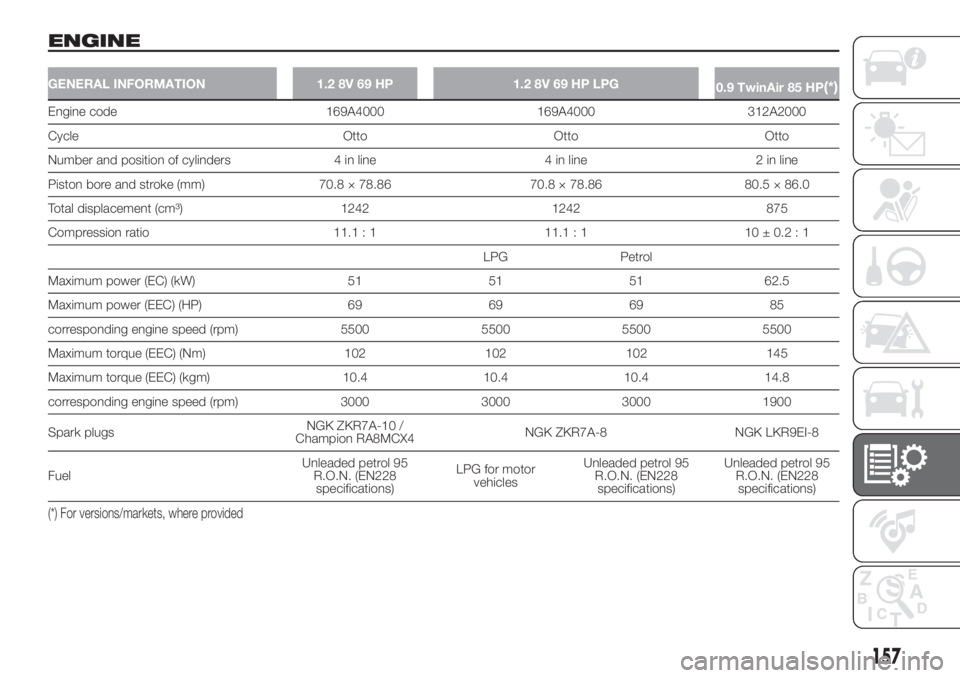
ENGINE
GENERAL INFORMATION 1.2 8V 69 HP 1.2 8V 69 HP LPG
0.9 TwinAir 85 HP(*)
Engine code 169A4000 169A4000 312A2000
Cycle Otto Otto Otto
Number and position of cylinders 4 in line 4 in line 2 in line
Piston bore and stroke (mm) 70.8 × 78.86 70.8 × 78.86 80.5 × 86.0
Total displacement (cm³) 1242 1242 875
Compression ratio 11.1 : 1 11.1 : 1 10 ± 0.2 : 1
LPG Petrol
Maximum power (EC) (kW) 51 51 51 62.5
Maximum power (EEC) (HP) 69 69 69 85
corresponding engine speed (rpm) 5500 5500 5500 5500
Maximum torque (EEC) (Nm) 102 102 102 145
Maximum torque (EEC) (kgm) 10.4 10.4 10.4 14.8
corresponding engine speed (rpm) 3000 3000 3000 1900
Spark plugsNGK ZKR7A-10 /
Champion RA8MCX4NGK ZKR7A-8 NGK LKR9EI-8
FuelUnleaded petrol 95
R.O.N. (EN228
specifications)LPG for motor
vehiclesUnleaded petrol 95
R.O.N. (EN228
specifications)Unleaded petrol 95
R.O.N. (EN228
specifications)
(*) For versions/markets, where provided
157
Page 174 of 228
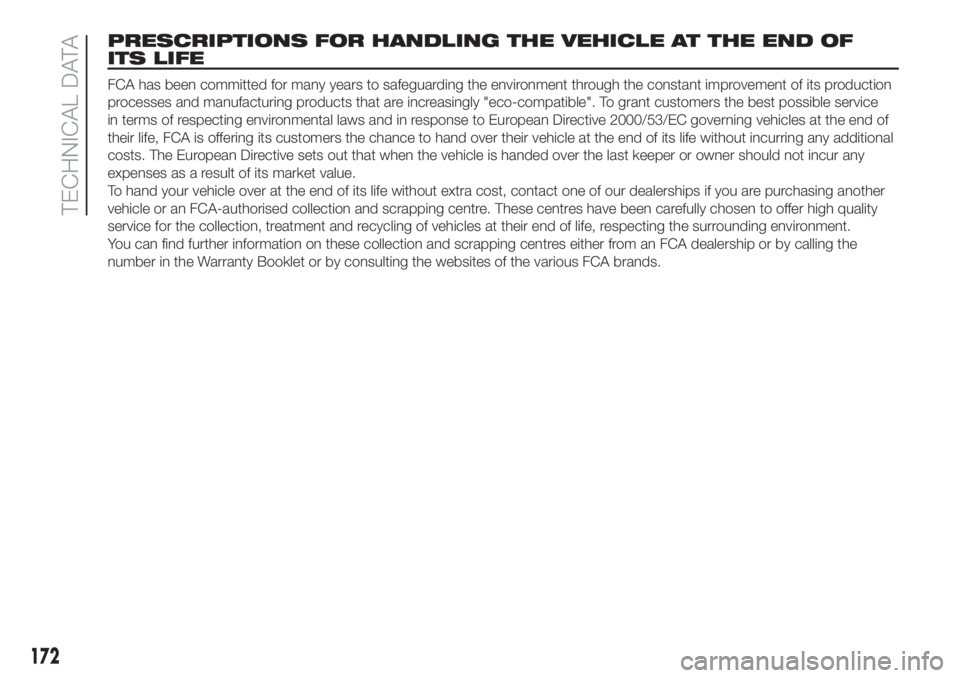
PRESCRIPTIONS FOR HANDLING THE VEHICLE AT THE END OF
ITS LIFE
FCA has been committed for many years to safeguarding the environment through the constant improvement of its production
processes and manufacturing products that are increasingly "eco-compatible". To grant customers the best possible service
in terms of respecting environmental laws and in response to European Directive 2000/53/EC governing vehicles at the end of
their life, FCA is offering its customers the chance to hand over their vehicle at the end of its life without incurring any additional
costs. The European Directive sets out that when the vehicle is handed over the last keeper or owner should not incur any
expenses as a result of its market value.
To hand your vehicle over at the end of its life without extra cost, contact one of our dealerships if you are purchasing another
vehicle or an FCA-authorised collection and scrapping centre. These centres have been carefully chosen to offer high quality
service for the collection, treatment and recycling of vehicles at their end of life, respecting the surrounding environment.
You can find further information on these collection and scrapping centres either from an FCA dealership or by calling the
number in the Warranty Booklet or by consulting the websites of the various FCA brands.
172
TECHNICAL DATA
Page 176 of 228
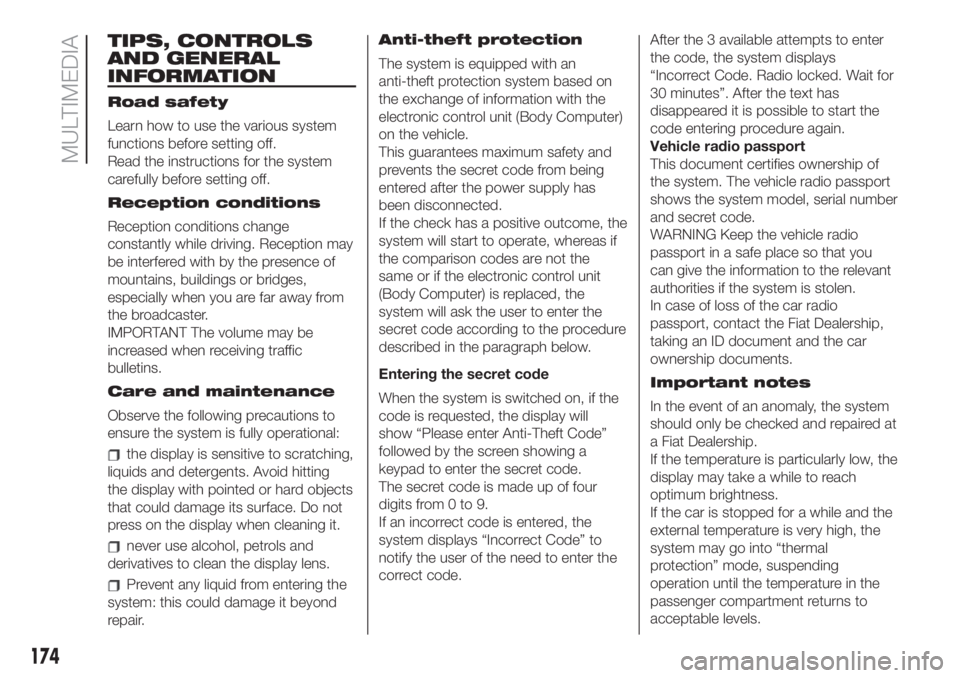
TIPS, CONTROLS
AND GENERAL
INFORMATION
Road safety
Learn how to use the various system
functions before setting off.
Read the instructions for the system
carefully before setting off.
Reception conditions
Reception conditions change
constantly while driving. Reception may
be interfered with by the presence of
mountains, buildings or bridges,
especially when you are far away from
the broadcaster.
IMPORTANT The volume may be
increased when receiving traffic
bulletins.
Care and maintenance
Observe the following precautions to
ensure the system is fully operational:
the display is sensitive to scratching,
liquids and detergents. Avoid hitting
the display with pointed or hard objects
that could damage its surface. Do not
press on the display when cleaning it.
never use alcohol, petrols and
derivatives to clean the display lens.
Prevent any liquid from entering the
system: this could damage it beyond
repair.Anti-theft protection
The system is equipped with an
anti-theft protection system based on
the exchange of information with the
electronic control unit (Body Computer)
on the vehicle.
This guarantees maximum safety and
prevents the secret code from being
entered after the power supply has
been disconnected.
If the check has a positive outcome, the
system will start to operate, whereas if
the comparison codes are not the
same or if the electronic control unit
(Body Computer) is replaced, the
system will ask the user to enter the
secret code according to the procedure
described in the paragraph below.
Entering the secret code
When the system is switched on, if the
code is requested, the display will
show “Please enter Anti-Theft Code”
followed by the screen showing a
keypad to enter the secret code.
The secret code is made up of four
digits from 0 to 9.
If an incorrect code is entered, the
system displays “Incorrect Code” to
notify the user of the need to enter the
correct code.After the 3 available attempts to enter
the code, the system displays
“Incorrect Code. Radio locked. Wait for
30 minutes”. After the text has
disappeared it is possible to start the
code entering procedure again.
Vehicle radio passport
This document certifies ownership of
the system. The vehicle radio passport
shows the system model, serial number
and secret code.
WARNING Keep the vehicle radio
passport in a safe place so that you
can give the information to the relevant
authorities if the system is stolen.
In case of loss of the car radio
passport, contact the Fiat Dealership,
taking an ID document and the car
ownership documents.
Important notes
In the event of an anomaly, the system
should only be checked and repaired at
a Fiat Dealership.
If the temperature is particularly low, the
display may take a while to reach
optimum brightness.
If the car is stopped for a while and the
external temperature is very high, the
system may go into “thermal
protection” mode, suspending
operation until the temperature in the
passenger compartment returns to
acceptable levels.
174
MULTIMEDIA
Page 177 of 228
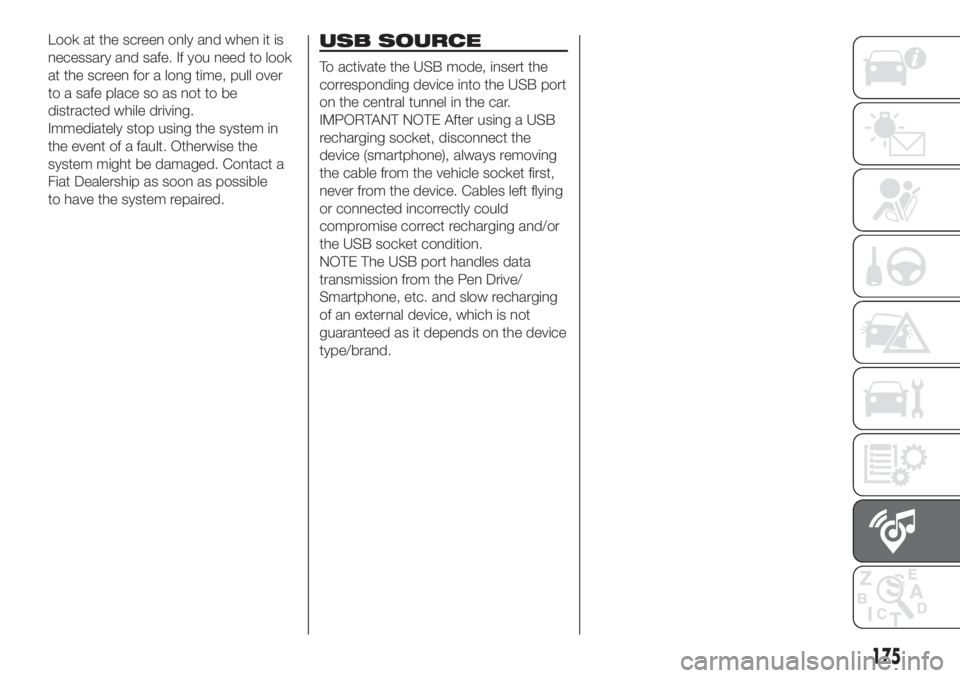
Look at the screen only and when it is
necessary and safe. If you need to look
at the screen for a long time, pull over
to a safe place so as not to be
distracted while driving.
Immediately stop using the system in
the event of a fault. Otherwise the
system might be damaged. Contact a
Fiat Dealership as soon as possible
to have the system repaired.USB SOURCE
To activate the USB mode, insert the
corresponding device into the USB port
on the central tunnel in the car.
IMPORTANT NOTE After using a USB
recharging socket, disconnect the
device (smartphone), always removing
the cable from the vehicle socket first,
never from the device. Cables left flying
or connected incorrectly could
compromise correct recharging and/or
the USB socket condition.
NOTE The USB port handles data
transmission from the Pen Drive/
Smartphone, etc. and slow recharging
of an external device, which is not
guaranteed as it depends on the device
type/brand.
175